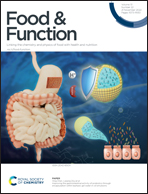Salecan ameliorates liver injury by regulating gut microbiota and its metabolites†
Abstract
Salecan, a natural β-glucan consisting of seven residues linked by β-(1→3)/α-(1→3) glycosidic bonds, is one of the novel food ingredients approved in China. β-Glucan has a variety of health-improving effects, yet its mechanism against liver injury remains poorly understood. β-Glucan can induce shifts in the gut microbiota and show health benefits; however, whether modulation of the gut microbiota by β-glucan is associated with its benefits remains unclear. Here, the hepatoprotective effect and potential mechanism of salecan supplementation using a model of CCl4-induced liver injury were investigated. After 8 weeks of treatment, salecan alleviated liver injury by regulating oxidative stress and activating the Nrf2 signaling pathway. In addition, salecan treatment modulated the composition of the gut microbiota, and the antibiotic cocktail treatment indicated that the hepatoprotective effect of salecan was dependent on the gut microbiota. Fecal microbiota transplantation was used to further verify this mechanism, and we confirmed that microbial colonization partially alleviated liver injury. Besides, microbiota-derived metabolites of salecan also contributed to the hepatoprotective effect of salecan against liver injury and inhibited oxidative stress. These findings supported that salecan intervention attenuated liver injury by regulating the gut microbiota and its metabolites.



 Please wait while we load your content...
Please wait while we load your content...